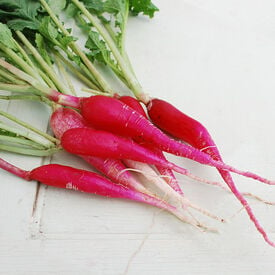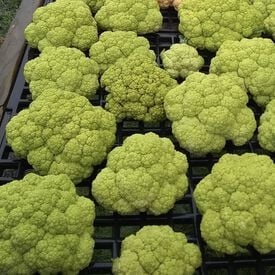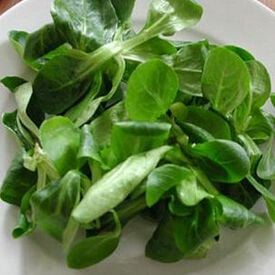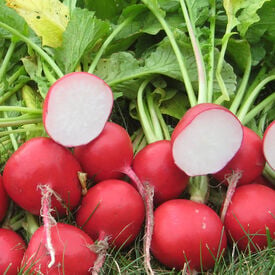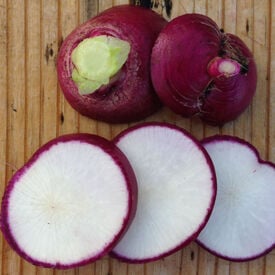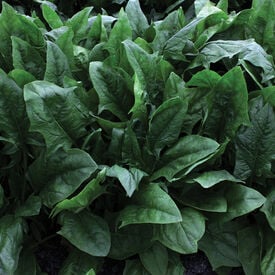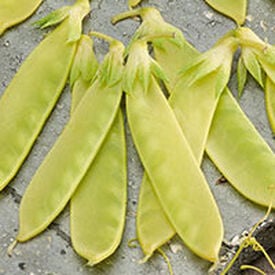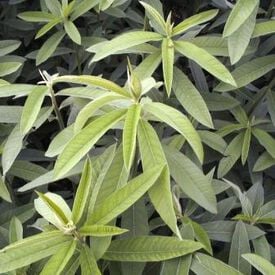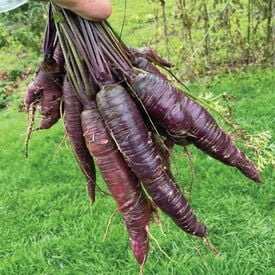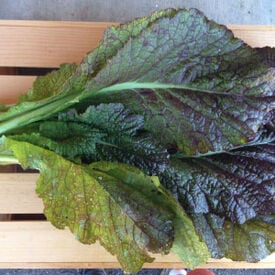The Cincinnati Market Radish is a uniquely skinny and elongated pink to red radish that is a fresh-from-the-garden-favorite! This six inch variety has a delicately mild taste with a very tender and crisp texture, making it perfect for fresh eating. The early maturing radish has been an heirloom garden favorite since 1885. You can enjoy the delicious Cincinnati Market from spring to fall.
Black Spanish Round Radish is a unique black old heirloom that has a nutty and slightly spicy flavor! This black beauty radish is making a comeback! Its firm flesh holds up well in meals. The Black Spanish Round is best grown from late winter to early spring and is a healthy spring vegetable.
The Vitaverde cauliflower, or "broccoflower," is the famous cross of broccoli and cauliflower! The Vitaverde broccoflower grows up to 1 pound. This hybrid has a vibrant green head, is heat tolerant and cooks fast with a mild sweet taste.
The Vit Mache, or also known as Lamb's Lettuce, is a green that is excellent for gourmet salads or as a garnish. Vit Mache produces good yields of 3" salad leaves. This green has a mild taste and is usually mixed together with Endive, Mustard, and Arugula. Vit Mache will produce a fall/winter harvest. Sow every 2 weeks.
Roxanne is a hybrid radish with uniform bright red color and a beautiful creamy white interior. Roxanne is a great tasting radish with no pithiness or bleeding even at a larger size. This radish stays firm and solid even when oversized, and holds well in the garden.
The Jerry Oats is a grain that is a quick growing green manure that will kill off any winter weeds and will hold soil with a mat of vegetation! This high yielding oat can produce over 100 bushels per acre. This grain variety is great for garlic beds and other vegetables. The oats stay green into November and form a mulched bed for spring planting. The Jerry Oats are also great for underseeding with a legume. Uses: Erosion prevention, Green Manure, Nitrogen Scavenger, No Till, Organic Matter, Weed Suppresion
The Purple Plum is an amazing purple skinned radish with a crisp, mild and sweet white flesh! This unique radish is different from the "typical" radish coloring. This small round shaped radish is early to harvest, which makes it great for home and market growers. Purple Plum is a nice variety to blend with other colors in mixes!
An excellent variety for home gardens and markets. Copenhagen Market grows up to 3-4 lbs and 6-8" in diameter. Grows as a compact plant with short stems. Great for slow cooking, coleslaws and sauerkraut.
Imperial Star is an Asian type spinach that is early maturing. This is a smooth-type spinach with medium sized green leaves. Grows upright on sturdy stalks. Perfect for cooler climates but also low bolt tolerance. Also has a high tolerance for downy mildew.
The Annual Ryegrass is a very fast growing grass that makes for a great cover crop as its fibrous roots prevent soil erosion and build organic matter! Plant this grass early fall to late fall, or early to mid-spring and can germinate in cool weather. The Annual Ryegrass established protective cover quickly and over seeds well at higher rates. This grass can scavenge as much as 200 pounds of nitrogen per acre. When used as a spring cover crop, this Annual Ryegrass should be killed before reaching seed formation stage. Ryegrass (Lolium sp.) Uses: Erosion Control, Green Manure, Nitrogen Scavenger, No Till, Organic Matter (Biomass), Weed Suppression
The Golden Sweet Pea is really the gold standard for yellow shelling peas! This yellow pod snow pea grows to be around 3 inches long. This pea has a wonderful sweet taste and can be eaten raw in salads or steamed as a side dish. The large 5-6 foot vines need to be trellised and will grow beautiful purple flowers. Certified Organic. Learn more about our organic seeds.
The Champion Radish is slow to become pithy. This radish is an excellent cooler weather variety, especially for short season climates. This bright red, crisp, round radish has large tops and is a good choice for early or late plantings. This highly recommended radish is great for eating fresh, in salads or for garnishes.
The Sunn Hemp is a legume that makes an excellent cover crop as it is great for nitrogen fixation and nematode resistance in the soil. This legume is a fast-growing legume that produces significant quantities of biomass and fixes nitrogen into the soil with a short rotation of 60 days under optimum conditions. Plant the Sunn Hemp at least 8 weeks before first frost. For maximum benefit terminate crop at first flowering, prior to developing fibrous, hard-to-manage stalks. This legume is tolerant of dry conditions. Avg. 15,000 seeds/lb. Uses: Compaction Control, Erosion Control, Green Manure, Nitrogen Fixation, Organic Matter (Biomass), Weed Suppression
The Austrian Winter Pea, sometimes called black pea or field pea, is a great cool season legume for cover crops, wildlife and winter grazing! This cool-season, annual legume has good, nitrogen-fixing capabilities. The Austrian Winter Pea is a low-growing, viny legume which has been shown to fix over 200 pounds of nitrogen per acre per year. It has hollow, slender and succulent stems, 2 to 4 feet long. The foliage is pale green, and the flowers are colored, usually purple, pink or reddish. Uses: Chicken forage, deer attractant, forage, green manure, nitrogen fixation, no till, organic matter (biomass), weed suppression
Purple Sun produces Uniform roots with smooth shoulders. Dark purple carrots that grow up to 10" in length. A great production carrot for fields, bunching and mechanical harvest.
Grand Rapid TBR lettuce is a versatile variety derived from the classic Grand Rapid lettuce, known for its resistance to diseases like downy mildew. Originating in the early 20th century, this loose-leaf type features frilled, light green leaves that form a rosette, offering both beauty and texture. The flavor is crisp and mild, making it a delightful addition to salads and sandwiches. Harvesting can begin around 45 days after planting, with the option to pick individual leaves for a continuous supply or to cut the entire head when fully mature. Grand Rapid TBR lettuce thrives in cooler climates and prefers well-drained soil, making it an excellent choice for both spring and fall gardens, particularly for home gardeners seeking a reliable and flavorful crop.
The Red Giant is a large mustard with an excellent, pungent flavor. This variety is a large purple-red leaf type. The Red Giant is great used as an ornamental or salad garnish. This variety's flavor has a slight hint of wasabi and grey poupon.
The Barkant Forage Turnip is an improved, early maturing, diploid turnip variety with a large purple tankard shaped bulb. Turnips have a high leaf to stem ratio and and provide very high concentrations of protein, sugar content and leaf yields. This turnip is ideally suited for grazing and it is common to obtain 4-6 tons of dry matter per acre of this high-energy feed. Uses: Chicken forage, deer attractant, forage
